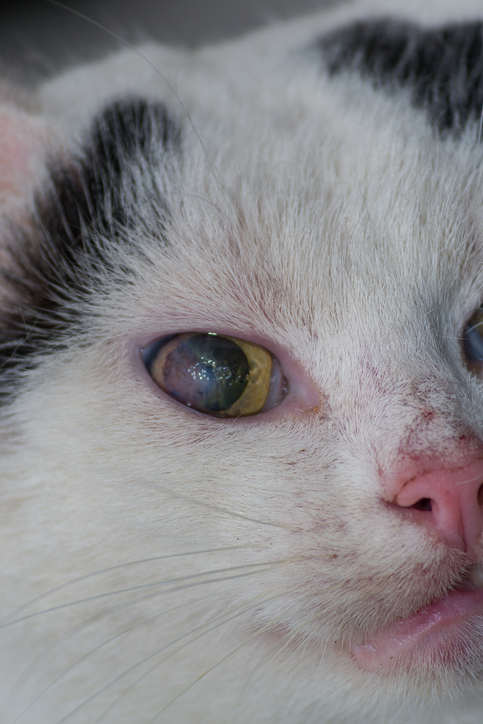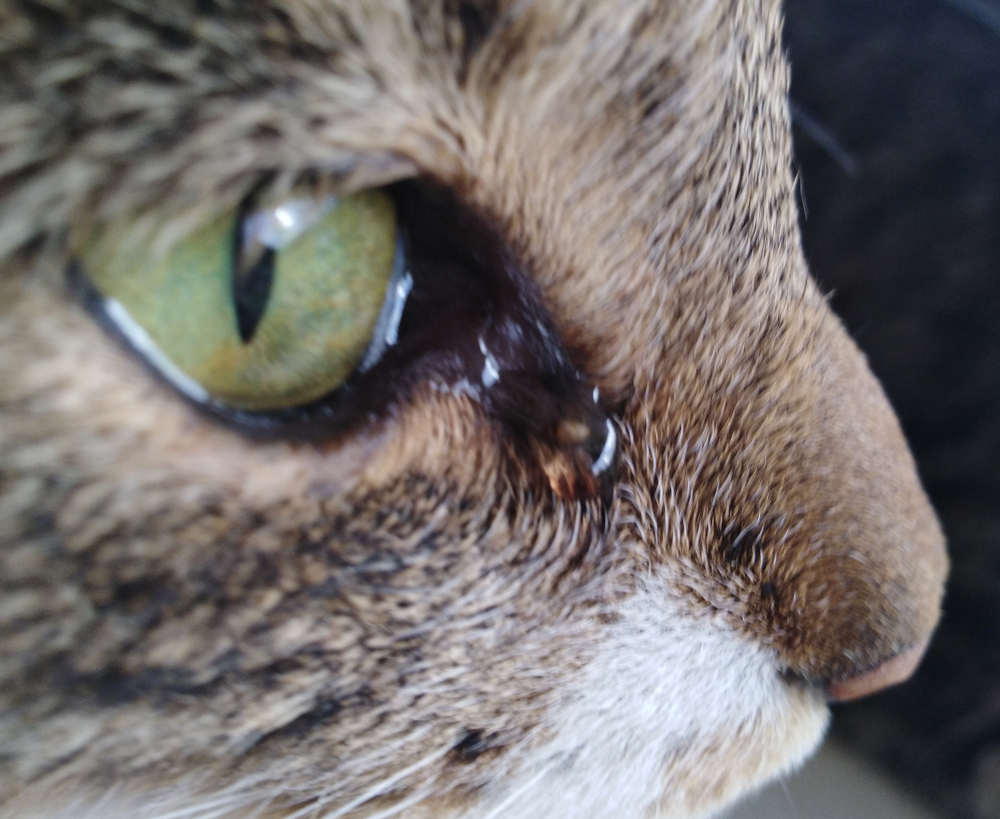Cat eyes can be susceptible to watery eyes and it’s important for the owners to be aware of this. As an experienced Veterinary Ophthalmologist, I have handled numerous eye problems in cats and treated them accordingly. In this article I will provide an overview of the various conditions that can cause watery eyes in cats along with their associated symptoms in order to help you identify and treat them quickly and effectively so that any permanent damage or loss of sight can be avoided.
Outline
Excessive tear production can be indicative of a problem, so don’t delay contacting your veterinarian. While a small amount of crusting may be normal, weepy eyes accompanied by continual weeping or sticky discharge shouldn’t be ignored. After all, eyes are too precious not to get checked out immediately if something seems off.
Your cat’s eye symptoms
When your feline friend has an issue with their eyes, some signs you may observe include:
- Pain/blinking/keeping one or both eye(s) closed
- Third eyelid protruding
- Ocular discharge or weeping
- Eye redness or swelling
- Eye cloudiness
- There is a lump developing in or around the eye
- Blindness
- Eye is bulging
- Blood in the eye
- A change in the size/shape of the pupil
- Coughing, sneezing or any other symptoms (read our article about cats sneezing, with watery eyes)
Common eye conditions causing watery eyes (and what to do)
1. Conjunctivitis:
Conjunctivitis, the most common of all feline eye disorders, is an inflammation of the thin mucous membrane (conjunctiva) that lines the inner surface of a cat’s eyelids and coats the outer surface of the eyeball. Many cats will experience at least a mild episode of the condition at some point in their lives. The clinical signs of the condition can be evident in either one or both eyes and will typically be observed as well in the third eyelid—the membrane positioned in the inner corner of a cat’s eye, between the lower eyelid and the eyeball.
The signs of conjunctivitis include:
- Pain/blinking/keeping one or both eye(s) closed
- Presence of a discharge that, depending on the cause of the conjunctivitis, can
be either colorless and watery or thick and dark-colored.
- The conjunctiva and third eyelid become swollen and red.
When to contact your vet
Contact your vet as soon as you notice a problem with your cat’s eyes – eyes are precious and the problem could get worse if they aren’t treated quickly. If your cat has had weepy eyes for a while, contact your vet for an appointment to have them checked. Even if the problem has been going on for a while, there is a chance that they could have a treatable condition.

2. Cat Flu
Cats, like humans, can be affected by a flu-like illness that presents with symptoms such as fever, sneezing, watery eyes, and runny nose. Cat flu is a contagious disease and once infected, cats may retain the virus for life. This can lead to them having long-lasting symptoms that persist throughout their lifetime. There is currently no definitive cure for the symptoms associated with a particular illness, however medical treatment can help reduce severity and speed up recovery. Kitten are usually more severely affected by infections than adults because their immune system is weaker and not as capable of combating it.
Symptoms of cat flu
- Weepy eyes
- Snotty nose
- Sneezing
- Low energy
- Painful eyes (flu can cause eye ulcers)
- Reduced appetite or no appetite at all
- Oral ulcers
- Fever
- Sore throat (you might notice difficulty swallowing or gagging)
- Coughing
When to contact your vet
If you notice any indications that your cat may have the flu, it is essential to contact your vet without any delay. Prompt action can prevent the condition from deteriorating rapidly.
Home care and home remedies for cat flu
Once your cat has been treated by your vet there are some things you can do at home to help them recover:
- Try to keep your cat’s life as stress-free as possible because stress can make illness worse.
- To encourage your pet to eat, try adding a little bit of warm food with strong scent like sardines, anchovies, or tuna to their meals, provided they do not have any allergies towards these items.
Prevention
Kittens can be vaccinated against flu and need to be given booster shots regularly, please speak with your vet concerning vaccinating your cat for cat flu.

3. Eye ulcers:
Corneal ulcers, which are injuries sustained to the cornea of the eye, must be treated in
order to resolve. If left unattended, they can result in severe consequences such as
blindness.
Feline corneal ulcers have a wide variety of potential causes, including:
- Viral or bacterial infection. According to Thomas Kern, DVM, associate professor of ophthalmology at Cornell University’s College of Veterinary Medicine, the most frequent cause is recurrent infection with the feline herpesvirus (FHV).
- Cat scratches
- Ingrown eyelashes
- Foreign body
- Expose to caustic chemicals
The clinical signs of corneal ulceration include:
- Inflammation surrounding the cornea
- Ocular discharge or weeping
- Clouding of the cornea
- Photophobia
- Squinting, rubbing the eyes, behaving as if having vision problems
When to contact your vet
If pet owners notice something wrong with their cat’s eye, it is important to take prompt action and consult a vet. The vet will conduct a thorough examination and then determine the best course of treatment.

4. Eyelid infection:
Blepharitis means inflammation of the eyelid.
The clinical signs include:
- Scratching or rubbing its face or eyelids leading to secondary trauma to the surrounding tissues
- Possible discharge from the eye that may be clear, mucoid, or purulent.
- Inflammation has been present for a significant amount of time, there may also be loss of pigment or hair
- Skin covering the eyelids may have dry crusts or flakes on its surface and small papules or pustules (pimples) may develop on the surface
- One or more meibomian glands (glands that help lubricate the eyes) along the margin of the eyelid may become swollen
- In more severe cases, the inflammation may spread and include conjunctivitis (inflammation of the conjunctiva) or keratitis (inflammation of the cornea)
The cause of blepharitis:
- Entropion
- Allergies
- Infections (bacteria, fungal, viral, parasites, or protozoal)
Cats that have been infected with feline herpes virus-1 (FHV-1) may develop chronic blepharitis as a secondary problem. Bacterial infections may cause localized abscesses of glands in the eyelids or generalized infections of the eyelids. In some cases, infection with Staphylococcus bacteria (staph) may lead to an allergic reaction, called Staphylococcus hypersensitivity.
- Tumors
- Trauma
- Occasionally other inflammatory disorders
Persian, Himalayan, and Burmese cats are more likely to develop blepharitis due to their facial conformation (flattened faces, and prominent folds of skin between the nose and eyes). These breeds of cats may have lagophthalmos (bulging eyes) and they are predisposed to lower eyelid entropion.
When to contact your vet
If pet owners notice something wrong with their cat’s eye, it is important to take prompt action and consult a vet. The vet will conduct a thorough examination and then determine the best course of treatment.

5. Tear staining in flat-faced breeds
Flat-faced breeds like Persians are more prone to tear-staining since they have large eyeballs in small eye sockets, which don’t allow the tears to drain away properly. This is a common issue for these types of cats, and needs to be addressed accordingly.
When to contact your vet
If pet owners notice something wrong with their cat’s eye, it is important to take prompt action and consult a vet. The vet will conduct a thorough examination and then determine the best course of treatment.

A picture of a flat face cat breed with watery eyes and tears of brown color that appear from the eyes.
6. Blocked tear ducts – cause tears to spill down the face
The lacrimal duct is part of the nasolacrimal system. The nasolacrimal system consists of a series of narrow tubes that allow tears to drain from the eye. This system allows excess tears to drain from the eye to the nose and mouth. While not as common in cats as in dogs, this nasolacrimal duct can become obstructed or blocked. Obstruction may result in tears overflowing and running out of the eye. This overflow of tears can lead to moisture and tear staining below the eye.
Source: McCracken T.O., Kainer R.A. and Carlson D. (2008) Color atlas of small animal anatomy: the essentials, : Blackwell Publishings.
The cause of lacrimal duct obstruction:
- Shape and size of the cat’s head and muzzle.
- Hereditary defect in the formation of the nasolacrimal duct. This defect results in the lack of an opening where the nasolacrimal duct meets the conjunctiva (pink tissue surrounding the eye). This is referred to as imperforate puncta.
- Inflammation or infection, within the eye or lacrimal duct, may lead to swelling that blocks the duct.
- Tumors that develop along the duct.
- Foreign material lodged within the lacrimal duct.
Treatment of lacrimal duct obstruction
Many cases of nasolacrimal duct obstruction are caused by inflammation. In these cases, anti-inflammatory medications and antibiotics may alleviate the obstruction. In other cases, surgery may be required for treatment.
When to contact your vet
If pet owners notice something wrong with their cat’s eye, it is important to take prompt action and consult a vet. The vet will conduct a thorough examination and then determine the best course of treatment.

